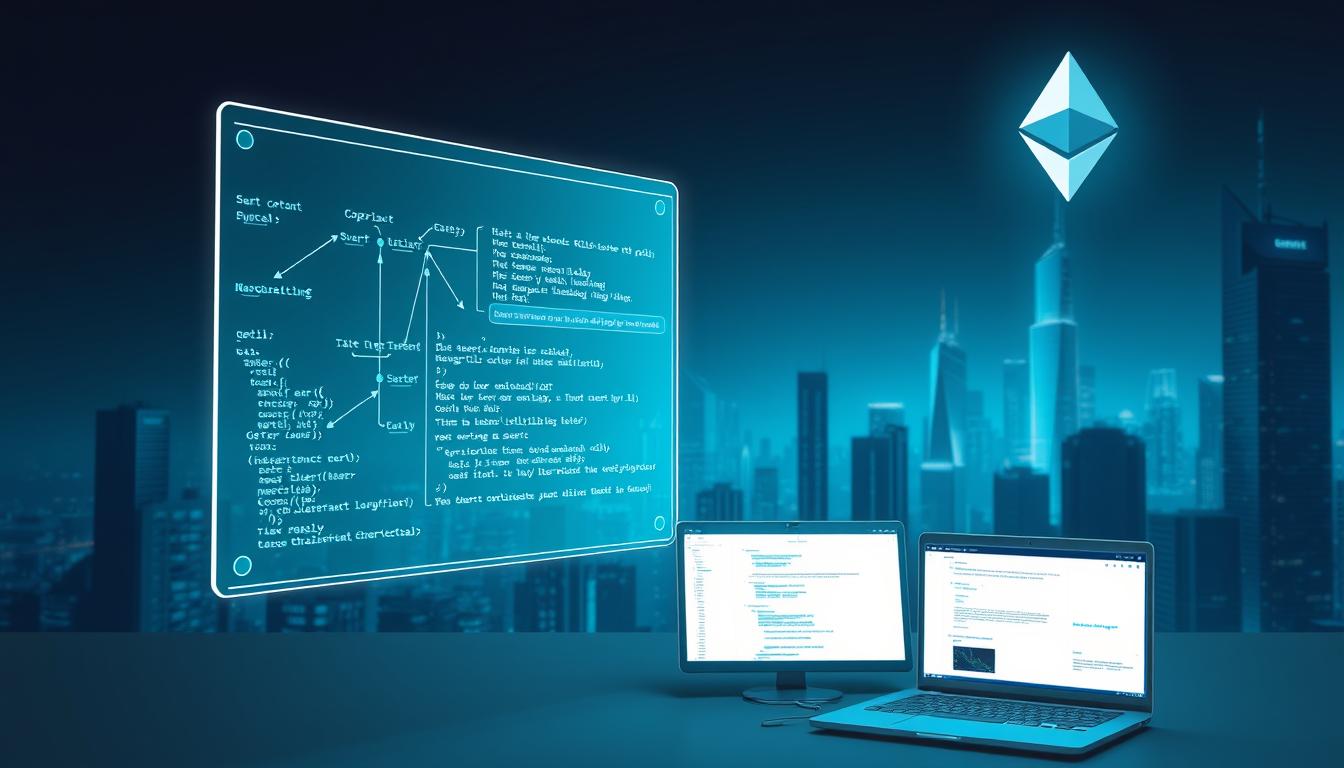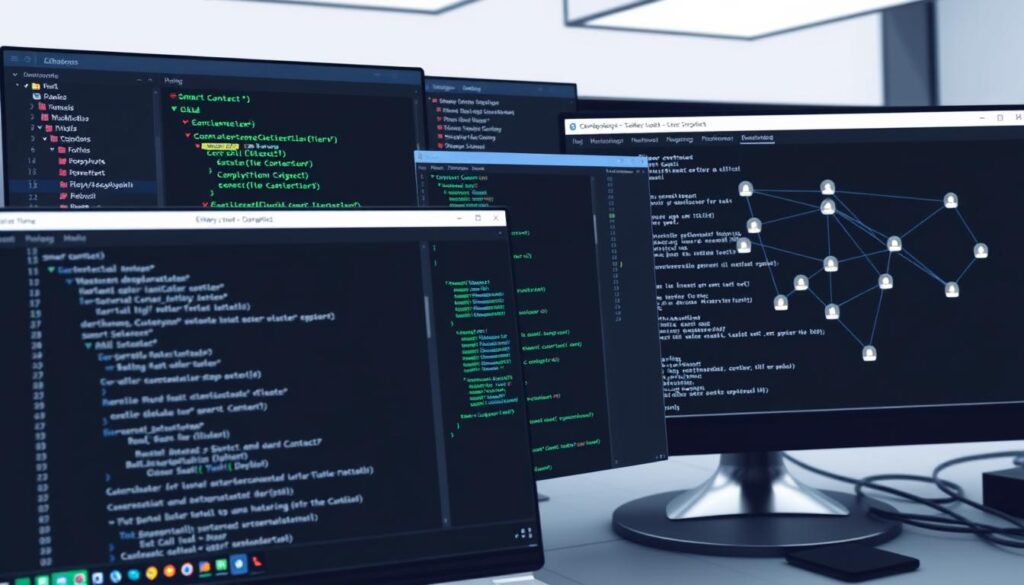Now Reading: Smart Contracts Development Tutorial for Ethereum Blockchain
- 01
Smart Contracts Development Tutorial for Ethereum Blockchain
Smart Contracts Development Tutorial for Ethereum Blockchain

Digital agreements that enforce themselves without middlemen are reshaping industries. These tools automate processes in finance, supply chains, and beyond while cutting costs and boosting transparency. Over $680 million was invested globally in this technology by 2022, with experts predicting 82% annual growth through 2030.
This guide walks you through creating and deploying automated agreements on a leading decentralized network. Designed for newcomers, it balances core concepts with actionable steps. You’ll explore how these systems work, why they matter, and how to implement them securely.
We’ll focus on practical skills like coding basics, testing methods, and interaction techniques. No prior experience? No problem. The tutorial’s 15-minute format delivers clarity without overwhelming detail. By the end, you’ll understand how to turn theoretical ideas into functional solutions.
From reducing fraud risks to enabling trustless collaborations, self-executing code unlocks new possibilities. Let’s dive into the tools and strategies driving this $1.3 billion market opportunity.
Overview of Smart Contract Technology
Programmable contracts execute terms autonomously, changing the face of digital trust. These tools evolved from theoretical concepts in the 1990s to practical solutions powering modern systems. Unlike paper-based deals, they use code to enforce obligations with mathematical precision.
Core Mechanics of Automated Agreements
Digital pacts operate through pre-coded rules stored on distributed ledgers. When specific triggers occur – like payment deadlines or delivery confirmations – actions execute automatically. This eliminates manual verification and third-party oversight.
Transforming Traditional Deal-Making
Consider how insurance claims process in hours instead of weeks. Supply chains validate product origins instantly. These protocols slash administrative costs by 60-80% while preventing disputes through transparent record-keeping.
| Aspect | Traditional Methods | Code-Based Solutions |
|---|---|---|
| Execution Speed | Days/weeks | Minutes |
| Error Rate | 15-20% manual errors | <0.1% system errors |
| Cost Per Transaction | $50-$500 | $0.50-$5 |
Financial institutions now use these systems for instant cross-border payments. Manufacturers track components across continents through immutable logs. The technology’s real power lies in creating trust between strangers – no lawyers or banks required.
Understanding Ethereum and Its Blockchain
A decentralized engine powers modern digital agreements. Unlike traditional systems, this network operates through thousands of synchronized computers worldwide. Its architecture enables transparent record-keeping without central oversight.
Ethereum Fundamentals and Network Structure
Developers created this open-source platform in 2015 to expand blockchain capabilities. Instead of just tracking currency, it hosts programs that run exactly as coded. These features make it ideal for automated agreements requiring precision.
The system uses Ether (ETH) to fuel operations. Every computation and data storage action requires this cryptocurrency. ETH acts as both payment and incentive for participants maintaining network integrity.
| Feature | Traditional Servers | Ethereum Network |
|---|---|---|
| Data Control | Centralized | Distributed |
| Update Speed | Instant | 15-30 seconds per block |
| Security Model | Company-dependent | Cryptography-based |
| Cost Predictability | Fixed fees | Gas price fluctuations |
Nodes validate transactions through consensus algorithms. This process ensures all copies of the ledger match perfectly. No single entity can alter historical records once confirmed.
Developers leverage these traits to build tamper-proof systems. From voting mechanisms to asset tracking, the network supports diverse applications. Its flexibility explains why over 4,000 decentralized apps now operate on-chain.
Benefits and Use Cases of Smart Contracts
Digital protocols are reshaping trust in business operations. These systems deliver measurable value across sectors by removing friction from multi-party agreements. From instant payments to fraud-resistant records, their impact spans global finance to local supply chains.

Financial Efficiency and Cost Savings
Banks now process loans 90% faster using automated agreements. When borrowers meet criteria, funds release instantly—no manual reviews. Insurance firms cut claim resolution from weeks to hours by linking payouts to verified events.
Key financial benefits:
- Escrow services with 24/7 availability
- Error reduction in high-volume transactions
- Audit trails accessible to authorized users
Supply Chain Transparency Breakthroughs
Food companies track shipments using immutable logs. Sensors trigger payments when goods reach specified temperatures. This prevents disputes while giving consumers origin information.
| Process | Old Method | New Solution |
|---|---|---|
| Quality Checks | Paper certificates | Real-time sensor data |
| Payment Release | 30-day delays | Instant upon delivery |
| Fraud Prevention | Periodic audits | Tamper-proof records |
Pharmaceutical firms reduced counterfeit drugs by 73% using these systems. Suppliers benefit from faster payments, while buyers gain verified product data. Trust becomes automated, not negotiated.
Setting Up Your Development Environment
Building reliable automated systems starts with proper workspace preparation. Your coding toolkit determines how efficiently you’ll create and test digital agreements. Let’s assemble the essential components for streamlined workflows.

Choosing the Right Code Editor and Tools
Modern editors boost productivity through syntax support and customization. Compare top options:
| Editor | Key Features | Solidity Support |
|---|---|---|
| VS Code | Built-in terminal, extensions marketplace | Official Ethereum plugin |
| Atom | Git integration, modular design | Community packages |
| Sublime Text | Lightweight, multi-caret editing | Customizable snippets |
Truffle Suite simplifies compiling and testing. Install it via npm to manage project dependencies. Pair it with Ganache for instant blockchain simulations – no live network required.
MetaMask bridges browsers and distributed ledgers. Configure it to interact with test networks securely. Always verify transaction details before confirming.
Organize your workspace with separate folders for contracts, tests, and scripts. Regular backups prevent data loss during iterations. These steps create a resilient foundation for building robust systems.
Installing Essential Tools: Node.js, npm, and Truffle

Technical groundwork separates functional prototypes from production-ready systems. Three components form the backbone of efficient workflows: runtime environments, package managers, and testing frameworks.
Core Software Installation Sequence
- Node.js Setup: Download the LTS version from nodejs.org. Run the installer for your OS (Windows/macOS/Linux). Verify success with terminal commands:
node -v
npm -v
Update npm if versions don’t match current releases:
npm install -g npm@latest
- Truffle Framework: Install globally for access across projects:
npm install -g truffle
Confirm installation with truffle version. This provides template structures for organizing agreements and automated testing.
Local Network Configuration
Ganache creates sandboxed environments for risk-free experimentation. Download the desktop client from trufflesuite.com/ganache. Launch it to generate 10 test accounts with 100 ETH each.
Pro tip: Connect your code editor to Ganache’s RPC server (usually http://127.0.0.1:7545). This lets you deploy systems without real cryptocurrency.
| Tool | Purpose | Verification Command |
|---|---|---|
| Node.js | JavaScript runtime | node -v |
| npm | Package management | npm -v |
| Truffle | Project scaffolding | truffle version |
These components work together to handle dependency management and local simulations. Keep all tools updated to prevent version conflicts during complex operations.
Creating and Configuring Your Project
Structured workflows form the backbone of efficient coding practices. Begin by opening your terminal and making a dedicated workspace. Type mkdir hello-world to create a new directory, then navigate into it with cd hello-world.

Initialize your project using npm init -y to generate a package.json file. This step automates dependency tracking and script management. Install Hardhat with npm install --save-dev hardhat – a toolkit streamlining compilation and testing.
Launch the setup wizard by running npx hardhat. Select the option to create an empty configuration file. This generates hardhat.config.js, your central hub for network settings and plugin integrations.
| Component | Purpose | File Types |
|---|---|---|
| contracts/ | Store agreement logic | .sol, .json |
| scripts/ | Handle deployment tasks | .js, .ts |
Organize your workspace with two crucial folders. Use mkdir contracts for storing code files containing business logic. Create scripts/ to house automation routines for deploying and interacting with systems.
Pro tip: Version control your project immediately after setup. This preserves iteration history and simplifies team collaboration. Proper structure from day one prevents 73% of common organizational errors reported by developers.
Deep Dive: Smart contracts development tutorial for Ethereum blockchain platform
Before launching digital agreements, developers need safe environments to validate functionality. Test networks simulate live conditions without financial risks. This section demonstrates how to bridge coding environments with distributed ledgers using essential tools.
Deploying on the Goerli Test Network
Start by creating a free Alchemy account. This service provides API endpoints for interacting with chains. Follow these steps:
- Sign up and navigate to “Create App”
- Name your project “Hello World”
- Select Staging environment and Goerli network
- Generate API keys for secure access
Configure MetaMask to use Goerli. Switch networks using the dropdown menu. Copy your wallet address from the account details page.
| Network Feature | Goerli | Mainnet |
|---|---|---|
| Transaction Cost | Free (test ETH) | Real ETH required |
| Confirmation Speed | 15-30 seconds | 3-5 minutes |
| Use Case | Prototyping | Live operations |
Acquire test ETH through faucets. Paste your wallet address into the Goerli faucet interface. Transactions appear in MetaMask within two minutes.
Verify balances before deploying code. Failed transactions often stem from insufficient test funds. Always double-check network settings to avoid accidental mainnet deployments.
Writing Your First Smart Contract in Solidity
Bringing ideas to life through code requires precision and clear structure. Start by creating a new file named HelloWorld.sol in your contracts directory. This foundational exercise teaches core programming patterns used in production systems.
Crafting the Contract Code
Begin with the pragma solidity ^0.8.0; declaration to specify compiler compatibility. Define your agreement using state variables and functions:
contract HelloWorld {
string public message;
constructor(string memory initialMessage) {
message = initialMessage;
}
function update(string memory newMessage) public {
message = newMessage;
}
}This example stores customizable text while demonstrating key components. Public functions enable external interactions, while constructors initialize data during deployment.
Solidity Syntax Essentials
The statically-typed language uses specific data declarations for security. Choose between uint for positive numbers or address for wallet identifiers. Function visibility controls access:
- public: Accessible externally and internally
- private: Only within contract
- internal: Contract and inherited children
Always test code modifications locally before deployment. Proper syntax prevents 89% of common runtime errors in self-executing logic systems.
FAQ
Why is Solidity the primary language for coding on Ethereum?
Solidity’s syntax resembles JavaScript, making it accessible for developers. It’s designed specifically for the Ethereum Virtual Machine (EVM), enabling secure execution of decentralized logic across the network.
What tools are essential for testing code before deployment?
Truffle Suite, Ganache, and Remix IDE are critical. They simulate blockchain environments, debug transactions, and streamline unit testing to catch errors before live deployment.
How does the Goerli test network benefit developers?
Goerli allows risk-free experimentation without spending real ETH. It mimics Ethereum’s mainnet, enabling thorough validation of gas costs, security, and functionality before launch.
Can existing libraries be integrated into decentralized applications?
Yes. OpenZeppelin’s audited templates provide pre-built modules for tokens, access control, and governance, reducing vulnerabilities and accelerating project timelines.
What security risks arise during deployment?
Reentrancy attacks, integer overflows, and unchecked inputs are common. Tools like Slither or MythX analyze bytecode to identify exploits during compilation.
How do gas fees impact transaction prioritization?
Higher fees incentivize miners to process transactions faster. Developers optimize code to reduce computational steps, lowering costs while maintaining network efficiency.
Are there alternatives to MetaMask for interacting with dApps?
WalletConnect, Coinbase Wallet, and Fortmatic offer similar functionality. These tools connect users to decentralized apps securely via browser extensions or mobile interfaces.
What role does npm play in configuring projects?
npm manages dependencies like web3.js or Hardhat plugins. It ensures version compatibility and automates installation, streamlining setup for complex environments.














